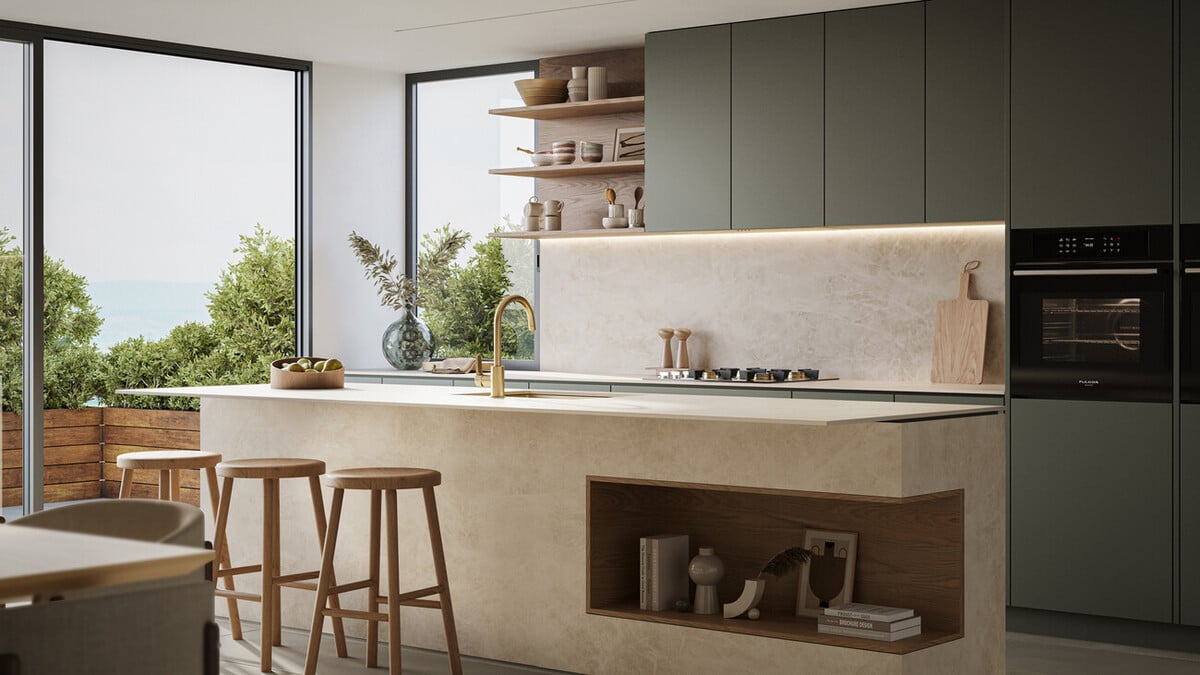
As well as your kitchen worktops, your choice of kitchen flooring can have a huge impact on the overall look and feel of the design. Some like to choose their flooring first then decide on the cabinetry and worktops to complement or contrast what’s underfoot. Others will select the rest of the scheme then look at the best kitchen flooring to suit. When installing new flooring into an existing layout, remember to remove cabinet plinths and, where possible, remove skirting boards for a snug fit. A professional fitter will be able to advise on any preparation work that’s required, which will depend on the subfloor below. In many homes, the subfloor will be concrete and if it’s in good condition and level, you will be able to install new underlay and flooring on top. If it isn’t up to scratch, you’ll need a self-levelling compound.
When the subfloor is made up of wooden floorboards, these should ideally be covered with a thin sheet of plywood to create a rigid surface, which can then be topped with underlay and your flooring of choice. If the house is a period property, it may need a damp-proof membrane to protect the flooring from moisture and you can buy underlay that has this built in so ask your installer for details. A professional flooring fitter should be able to carefully lift up the corner of an unseen piece of any existing flooring to see what lies beneath and advise you accordingly.
 Solid timber floorboards are perfect for a classic kitchen look with woods such as pine, maple and hickory adding warmth and character to a Shaker design
Solid timber floorboards are perfect for a classic kitchen look with woods such as pine, maple and hickory adding warmth and character to a Shaker design
Material options
Hardwood flooring should be professionally laid, as it can contract and expand with changes in humidity and temperature. Your fitter will be able to tell you if any remedial work is needed on the subfloor and they will also take moisture readings. Popular hardwoods include oak and walnut - opt for a lacquered finish rather than oiled, as stains are less likely to penetrate and mark the wood beneath. It’s a great choice for traditional kitchen schemes. Engineered wood creates a similar look, as it’s made up of layers of high-density fibreboard with a hardwood top. It’s often chosen over solid wood for kitchen flooring because it is more stable and can be laid in a floating fashion by resting on the subfloor. For this reason, it is usually more expensive. It’s best to have it professionally laid but with the latest click-together planks, it could be installed as a DIY project and shouldn’t take more than a weekend.
Highly durable and stain-resistant, laminate is easy to clean and comes in a wide range of price points and designs, from bleached wood effects to Carrara marble styles. One concern may be the fact that laminate doesn’t absorb sound very well but an acoustic underlay will help.
For those interested in vinyl, there are two types – cushioned vinyl that comes in sheet form and luxury vinyl tiles or planks – both of which mimic the look of wood or stone without the maintenance or price tag to match. Luxury vinyl is extremely hardwearing, scuff, slip and dent resistant. Cushioned vinyl is perfect for a quick and inexpensive update, as it’s easy to lay and comes in various styles.
Porcelain and ceramic is another option and this is available in a wide range of styles, finishes and textures. Some have rectified edges, which means that the tiles can be laid with narrow grout joints in between. They are easy to clean and can replicate the look of natural stone or wood with its knots and grains. They are porous, like stone, so will need sealing before and after fixing. The exception is glazed porcelain, which doesn’t require sealing. Porcelain tends to be more expensive than ceramic but it is less likely to scratch or chip.
Natural stone on the other hand brings a rustic look with everything from the deepest darkest slate to the lighter tones of limestone, travertine and marble. Any natural stone will need to be thoroughly sealed during the fixing process to prevent staining and it must be solidly bedded. There are a range of finishes to choose from including polished, tumbled, hammered and honed.
 Experiment with the Caesarstone visualiser to mix and match your flooring, worktop and splashback. This image shows a Vanilla Noir floor that co-ordinates with matching splashbacks.
Experiment with the Caesarstone visualiser to mix and match your flooring, worktop and splashback. This image shows a Vanilla Noir floor that co-ordinates with matching splashbacks.
Consider quartz
Did you know that as well as providing the perfect surface material for worktops, quartz can also be used for kitchen flooring? For those who love the look and feel of natural stone, quartz is the perfect hardwearing, high quality alternative. It’s one of nature’s strongest minerals and as well as being impervious to stains, scratches and cracks, it also offers almost unlimited design options. There are concrete effects for an industrial vibe, marble finishes for a luxe look and sparkly granite-style slabs for a touch of bling.
Leading designers will often collaborate with Caesarstone to set new trends and create innovations in surface style. There are also plenty of new designs to choose from as well as a popular palette of enduring styles. Another advantage of choosing quartz is that you can match your flooring to your worktops, splashbacks and even wall cladding for a fully co-ordinated look. Go for the same style throughout or mix and match by selecting different finishes and colours for floors and surfaces. Caesarstone’s Visualiser is a really helpful interactive online tool that allows you to play around with different looks; showing instantly how different quartz surfaces will look on floors, walls, worktops, islands and splashbacks.


